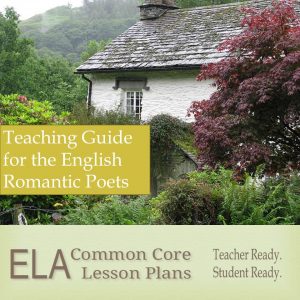Whether you call Wordsworth’s poem “Daffodils” or “I Wandered Lonely as a Cloud,” you’ll find this poem analysis helpful. And if you’re looking to teach or write a poetry analysis, check out this lesson.
The Foundation of William Wordsworth’s Poems

Yes, you can spend multiple class periods on poetry without the dreaded 2-minute reading followed by 49 minutes of stammering. The British Romanticism Teaching Guide includes an overview of British Romanticism and an analysis of selected poems by William Blake, William Wordsworth. Samuel Taylor Coleridge, Lord Byron, Percy Shelley and John Keats.
Of all the famous poems of Wordsworth, none is more famous than “I Wandered Lonely as a Cloud”. To fully understand the poem and any William Wordsworth poetry analysis, a brief look at the tenets of British Romanticism is in order. British Romantics emphasized the following.
- The Beauty of the Supernatural – a William Wordsworth poetry analysis will invariably identify a connection between nature and the supernatural. “I Wandered Lonely as a Cloud” is no exception.
- The Importance of Nature – The obvious theme of the poem is the beauty of nature and its ability to allow one to connect with God.
- Championing the Individual – The narrator’s experience in the meadow is personal and individual.
- The Dangers of Technology – There is no overt reference to technology. Romantics, however feared that man’s ability to connect with nature was being compromised by technological advances.
“I Wandered Lonely as a Cloud” by William Wordsworth
That floats on high o’er vales and hills,
When all at once I saw a crowd,
A host, of golden daffodils;
Beside the lake, beneath the trees,
Fluttering and dancing in the breeze.Continuous as the stars that shine
And twinkle on the milky way,
They stretched in never-ending line
Along the margin of a bay:
Ten thousand saw I at a glance,
Tossing their heads in sprightly dance.The waves beside them danced; but they
Out-did the sparkling waves in glee:
A poet could not but be gay,
In such a jocund company:
I gazed—and gazed—but little thought
What wealth the show to me had brought:For oft, when on my couch I lie
In vacant or in pensive mood,
They flash upon that inward eye
Which is the bliss of solitude;
And then my heart with pleasure fills,
And dances with the daffodils.
“Daffodils” Analysis

Imagine having 11 complete poetry units with handouts and lesson plans completed. You don’t need to imagine. These units are teacher ready and student ready. Just print, make copies, and accept accolades from colleagues and students.
Before continuing, print the poem. An analysis of “I Wandered Lonely as a Cloud” produces the following observations.
- Rhyme Scheme – ababcc – the rhyming couplet at the end of each stanza produces a natural break to go along with the natural break caused by a new stanza. The last line of each stanza, therefore, carries added emphasis. The last line mentions “the show” and produces images of dancing daffodils, a lasting impression of an impression Wordsworth discusses.
- Meter and Rhythm – iambic tetrameter. The meter creates a song like rhythm, a rhythm to which daffodils might dance. Wordsworth also uses alliteration and consonance to create rhythm.
- Line 1 contains a simile comparing the narrator to a cloud, making him at one with nature. The comparison to the cloud suggests free floating and drowsiness. The narrator is relaxed. A “host of golden daffodils” attracts his attention.
- Line 7 uses a simile to compare the procession of daffodils to the eternity of the stars in the milky way, creating a link between Nature and the Universe which links the narrator to the Universe.
- Line 9 uses hyperbole to express the vastness of the vision, an eternal vastness perhaps: “They stretched in never-ending line.”
- Line 12 uses personification. The daffodils have become a living entity.
- Line 13 uses personification and comparison. The waves danced too, but they do not produce the glee the daffodils have created.
- In stanza 3 the narrator admits that at the time of the incident, he had no idea of the impact.
- Stanza 4 relates that the subconscious and the soul receive the greater impact from the experience as the daffodils “flash upon that inward eye.”
- Theme: In order to understand oneself and one’s place in the universe, one must connect with nature.
